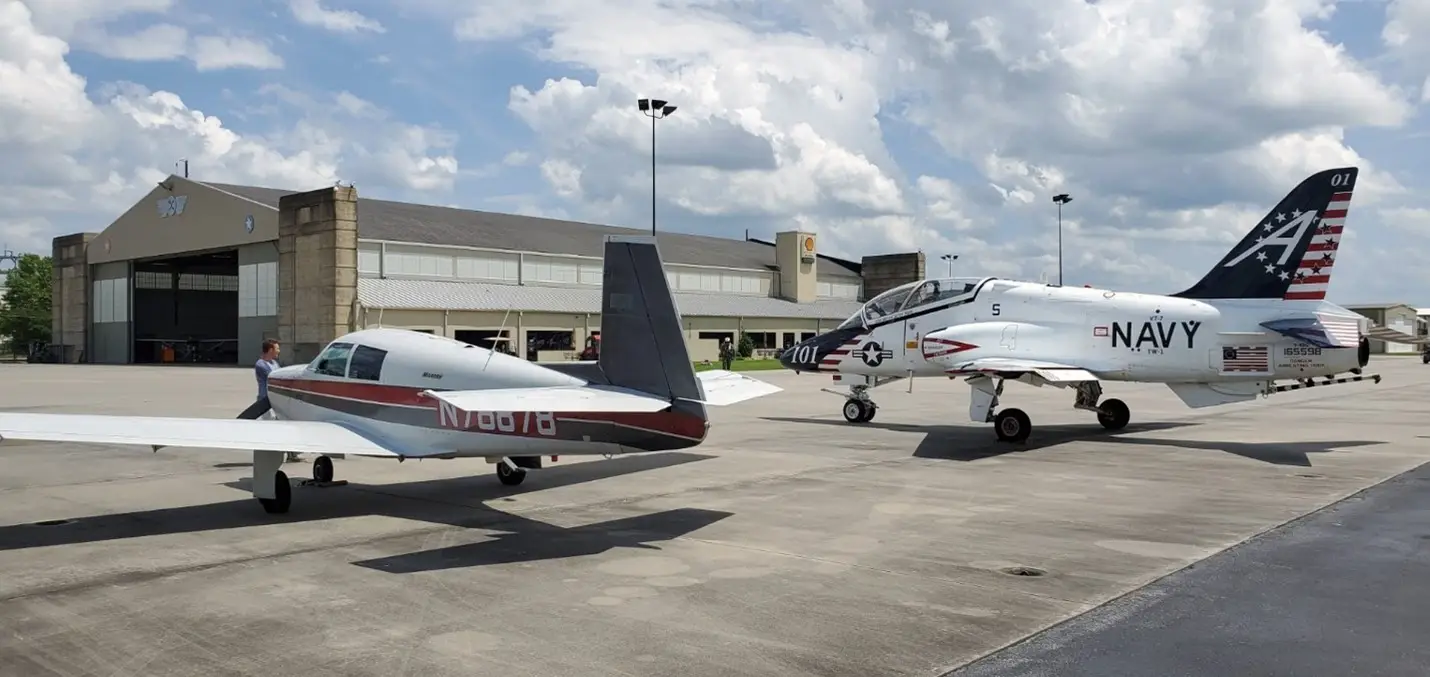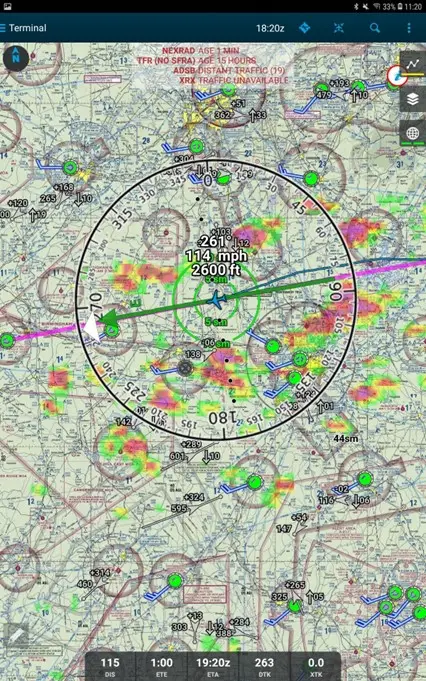**Note – This article was first published in The Mooney Flyer in February 2021.
Be Flexible
Here we are with the third installment, the one where we wrap up everything you need to know for a long cross-country. Yes, I’m kidding. I don’t think that someone could ever tell you everything you need to know, because there is always something new to learn, but this is the third and final installment. Helmuth von Moltke was the 19th century leader of the Prussian Army and once said, “No battle plan ever survives first contact with the enemy.” If he was a Mooney pilot he might have said “No cross-country planning survives unchanged past take-off.” The reality is that often your plan will not survive the pre-flight briefing without changes.
We aren’t flying at Cessna or Cherokee speeds which greatly increases your chances of flying into a new weather system, and we are talking about going on long trips which means you will likely fly into a new weather system. I have two tips for this concern. First, technically having weather available in the plane is not required, but it is really nice, and once you have flown a cross-country trip with it you will never want to fly another one without it. If you missed last month’s article go back and read it where I talk about inexpensive options for getting weather on a tablet in the plane. Always remember that the radar images are delayed and only for strategic, not tactical planning. They will help you go around a system, but you don’t want to roll the dice and think they will help you pick your way between cells. If you want a good example of how not to use in cockpit weather check out the Air Safety Institute video of the fatal crash of a Piper Cherokee Six.
The second part of the weather factor is preparation. On a long trip I start watching the en-route weather and at my destination about a week in advance. I do this to get a feel for the way the weather is trending, and it helps me adjust departure times and the route. (I’m currently just a VFR pilot but that hasn’t stopped me from flying between 100-140 hours each of the past four years, mostly on long cross-country trips). Before I fly, I get a full briefing online from 1800wxbrief.com, and if I have any questions I will call in and talk to a briefer as well.
The third part is to be flexible. Be flexible with your departure/arrival times, be flexible with your route, and even be flexible with your destination. Always leave yourself an out. Never get stuck having to be somewhere, “get-there-itis”. If you absolutely must be somewhere at a certain time either take a commercial flight or drive.
Weather Diversions
I like to tell stories, so let me tell a few relating these points to my flying experiences. In June of 2017 with about 120 total hours of flight time we planned a trip from Southern California to Rexburg, ID, (KRXE) a total of about 700nm. This would be the longest trip I had ever made, and when we made a fuel stop and we were still heading away from home it felt great! I had been watching the weather, and the only thing of concern were the typical summer thunderstorms that pop up in the mountain west. I got a briefing before leaving Fullerton (KFUL) and it was clear flying all the way to our fuel stop in Delta, UT (KDTA). While on the ground in Delta I checked the weather again and saw storms north of the UT/ID border. Instead of just an online briefing I called in for a full briefing, looking for some further insight. The briefer said that there was a small system just north of the UT/ID border but that it would likely dissipate before we got there. If it didn’t he said we would probably be able to get around it by diverting west of Pocatello, about 40 miles west of our intended route.
After 15-20 minutes on the phone with the briefer we decided to give it a go, but before we did that, I got in touch with my sister in Salt Lake as a back-up plan. If we had to turn around, we would come back to Salt Lake and spend the night at my sisters. Always have a backup plan to divert somewhere and stay with someone you know or get a hotel room. While small towns are great, keep in mind you will have more options for transportation and lodging in larger towns/cities, and in the current age of Covid keep in mind that some airports will not have their courtesy car available.
Back to the Idaho adventure and how weather on the tablet helped get us to our final destination. I spent the next 45 minutes of flying watching the weather on the tablet and out the window. With the weather on the tablet, I could see that the storms were all moving directly to the east and that on the other side of them Rexburg was clear, so I knew if they didn’t dissipate, I could at least go around them and reach my destination.

Visibility was excellent and as I watched one particular storm both on the tablet and out the windscreen it was obvious that it would be right on us as we reached 9,300’ Mount Oxford, so we made a turn to the west. We would turn north after passing that storm and then make a further diversion westward to get around a storm over Pocatello that just wasn’t going anywhere. Once on the north side of those storms we had a great tailwind, cruising along just above 200 mph ground speed, not bad for my little old M20D. The diversions cost us some time and had us landing just after dark, but we arrived safely without any excitement. (I like boring trips). Without the weather on the tablet, seeing the storms in front of us, we would have turned back to Salt Lake, but having the big picture of the weather let me make strategic decisions to get around the weather to our destination.
Sometimes You Just Drive
Sometimes you will watch the weather for a week leading up to a trip and decide to drive. You will have times you find out you could have flown, and times the actual weather confirms you made the right choice to drive.
A little over a year ago we had to be in Salt Lake to see my son-in-law receive his master’s degree. It was an event not to be missed. The weather looked good for flying in, but there was a snowstorm that was supposed to arrive that night and last 2-3 days. The only change in the forecast over the week leading up to the trip was that the storm forecast got worse, not better. I had to be back at work the next Monday and did not want to risk being trapped on the ground, so we made the 10-hour drive. As forecast, the weather was clear on arrival day. I went to bed that night expecting to wake up to snow. I woke up once in the night, looked out the window and could still see stars in the clear night sky, despite the snowstorm that was supposed to begun around midnight. The next morning it was a high overcast sky and by mid-morning when we were leaving the snow was still not falling. We could have flown.
Fast forward a year later to the end of December 2020 when we needed to go to Idaho for my son to attend his best friend’s wedding. It was a trip made for the Mooney, and I didn’t want to drive 13+ hours each way. After a day in Idaho Falls, we were to go back down to Salt Lake for a couple nights and then return to California. Again, I watched the forecast for 10 days leading up to the trip. It was supposed to snow the evening after our scheduled arrival and then possibly clear up the next day. For ten days the forecast didn’t change, and we finally decided we would drive. We arrived in Idaho Falls an hour before the wedding reception to snow flurries and left the reception with a few inches of snow on the roads. The next morning when we would have been flying to Salt Lake it was low overcast, freezing, and horrible visibility. I kept an eye on the weather throughout that day and the next. We would have been trapped on the ground in Idaho Falls and missed seeing family in Salt Lake.
The moral of those two stories? Sometimes you could have flown, and sometimes you could not. I am fairly conservative when it comes to my flying. As I said before, I like boring flights. Never regret those times you could have flown and didn’t. As the saying goes, “It is better to be on the ground wishing you were up there, than being up there wishing you were on the ground.”
Coast-to-Coast VFR Only
The last topic related to the weather, be flexible. When we made the decision to fly coast to coast in 2019, we picked a month and a tentative window. If we found a 10-day forecast that looked favorable, then that was when we would go. On the trip each evening I planned for two different fuel stops and destinations, far enough north and south of our route to hopefully have different weather. The next morning when we got up, I would look at the forecast and decid which route we would take. It was a stretch for me because I like to have everything planned out well in advance, but it led to some great adventures. On the way there we saw some beautiful country and due to changes in our route had a last-minute meet-up with a friend in Memphis for what is the best Bar-B-Que I have ever had. We had a great time in North Carolina and the Eastern Shore of Virginia and even landed at First Flight.
For the return trip I had looked at the weather forecast and planned to take a northern route through Kentucky and Missouri. I had fuel stops and final destinations picked out in the evening but woke up to find the forecast was all wrong and our route was already blocked by thunderstorms. However, in a Mooney if you are making a multi-day trip changing your route by 2-300 miles is not a big deal and can be fun. We ended up taking a southern route and landed in Augusta with views of Augusta National on final. Next we stopped in Meridian Mississippi and pulled up on the ramp next to a couple of T-45 Goshawks and a T-38 Talon.
We even used the weather on the tablet to steer clear of some scattered storms over Alabama.
Maintenance Away From Home
The last item to wrap up this discussion on cross-country flying is what about maintenance away from your home base? This one is actually the easiest. Carry a credit card with a decent limit on it! Before you get out the pitchforks to lynch me, I said the “easiest” but did not say the “cheapest.” If you are away from your home base and something breaks, there isn’t much that money and time can’t fix. For the first three years and 300+ hours I carried a small tool box with quite a number of things in it, and given the actual simplicity of a Mooney (at least a Vintage Mooney) I could have disassembled much of the plane with what I had in the baggage compartment. In all that time, the most I ever did was swap out a spark plug that had shorted out. Now I carry a couple screwdrivers, a set of pliers, a spare spark plug, and the wrenches needed to change a plug along with a couple quarts of oil. I do a lot of the work on my plane under supervision of my AP/IA, but anything more major than changing a plug on the road and I’m just going to pay someone to fix it.
If you fly long enough, there is a good chance you may be stuck leaving your plane somewhere to get fixed and coming back later for it, but it’s “just time and money.” I’m going to knock on the wooden end table as I type this, but the plane doesn’t know if you are 50 miles from your home base or 500 miles away. It is not going to just quit on you because you flew outside of a certain radius…
So, there you have it, a far cry from all inclusive tips for cross-country flying, but hopefully some thoughts and ideas to get the creative juices flowing and head out on some new adventures in the year ahead.



